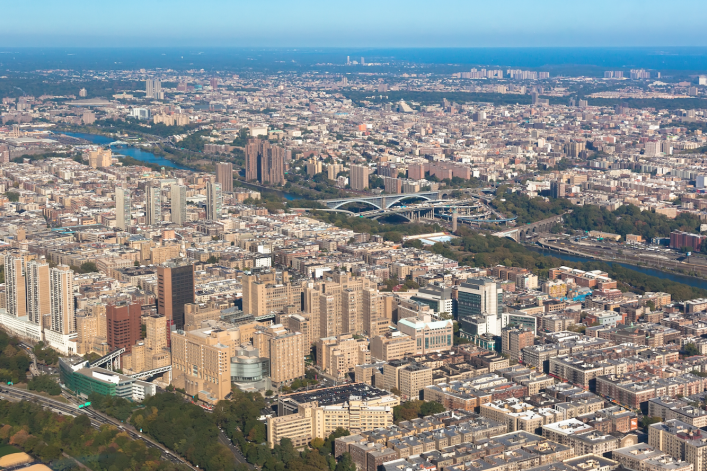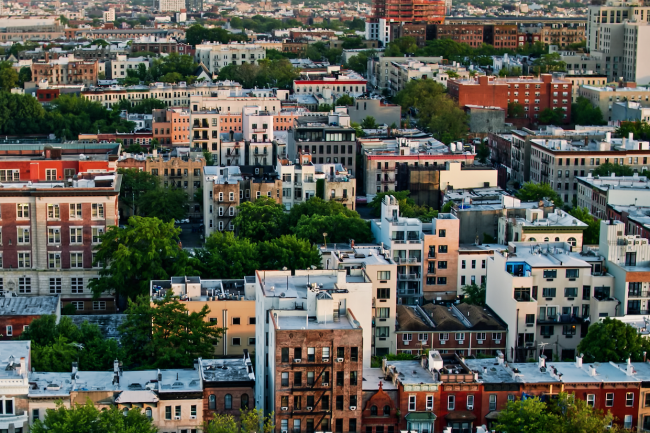Looking for a cheap apartment? Here are NYC’s most affordable neighborhoods for renters in 2021

Upper Manhattan is your best bet for a deal if you don’t want to head to the outer boroughs.
iStock
If you’re trying to find a rental in New York City, chances are you’re having a lot of trouble finding the apartment you want in the neighborhood in which you want to live. That’s because competition for apartments in the city is very steep at the moment and rents are climbing.
Demand for new leases means landlords are no longer offering the concessions that they were during the pandemic, like several months rent free. Gone too are the Covid discounts that attracted new renters to the city over the past year. Now bidding wars for rentals are breaking out in the city’s most popular areas—with winning bids going to renters willing to pay hundreds more than landlords are asking.
Of course, some neighborhoods are more affordable than others. If you don’t have to be in a specific neighborhood, or if you have some flexibility—perhaps your job has gone partially or fully remote, so your commute takes up less time during the week—you may be able to move to a less expensive neighborhood, one that's not even on your radar yet.
So where is that exactly? To find out, we asked the data scientists at listings site RentHop to pull median rents for one-bedroom apartments in Manhattan, Brooklyn, Queens, and the Bronx. (Staten Island was excluded because there isn’t enough rental inventory.) Below, the three least expensive neighborhoods in each of the four boroughs.
With New York City rents at record highs and supply at historical lows, apartments in so-called "affordable" neighborhoods are still expensive and in hot demand. And even if you're the first one in the door, your application will be rejected by most landlords if your annual salary is less than 40 to 45 times the monthly rent. That's why smart renters prequalify themselves by lining up a guarantor ahead of time who earns at least 80 times the monthly rent and resides in New York. (Some landlords will also allow guarantors from New Jersey or Connecticut.). Or, you can turn to the Insurent Lease Guaranty Program. Accepted at more than 8,000 buildings across the city, the Insurent Lease Guaranty is a quick and easy way to get the apartment you want. Click here to learn more.
Manhattan: Inwood, Marble Hill, and Washington Heights
Upper Manhattan is your best bet for a deal if you don’t want to head to the outer boroughs. The far northern reaches are home to the three most affordable neighborhoods to rent in Manhattan: Inwood is the most affordable (where a median one-bedroom rent is $1,733), followed by Marble Hill ($1,800), and Washington Heights is a close third ($1,850).
“We know why they are priced that way—it’s a little bit further to travel—as you get further away from the heart of the city,” says Heather Huff, an agent at Bohemia Realty Group. The gap between the priciest and cheapest neighborhoods is steepest in Manhattan—in Tribeca, the most expensive neighborhood, the median rent for a one bedroom is $5,700.
The good news is that in Upper Manhattan, Huff says, it’s still possible to find no-fee apartments and some landlords are also still giving one month free. “There are definitely some good incentives, especially as we move out of summer and get into the slower winter months,” she says.
During the summer, these areas are popular with students, often looking for three- or four-bedroom shares. So if you want a bigger place, looking in the off season you’ll typically find less competition. “Those are generally harder for a landlord to rent in that off-season time,” Huff says.
Inwood and Washington Heights both offer easy access to the 1 and A trains, and both have access to parks. Inwood has Inwood Hill Park and Fort Tryon Park, plus cultural sites where you can enjoy the outdoors, like the Cloisters and Dyckman Farmhouse.
Washington Heights offers access to Highbridge Park, Riverside Park, and Riverbank State Park. (For more intel on these neighborhoods, check out Brick’s “Washington Heights vs. Inwood: Which neighborhood is for you?”)
Marble Hill is attached to the landmass of the Bronx but officially part of Manhattan—it’s cut off by Spuyten Duyvil Creek (Bronx residents will tell you that the distinction is meaningless, that the area is culturally part of the Bronx. In fact, once a year a group of people even come together and plant the Bronx flag in the neighborhood.) Marble Hill was previously one of Brick’s “5 best Bronx neighborhoods to check out.”
In terms of transportation, the 1 stops at 231st Street, and the Metro-North stops in Marble Hill, making the area a more transit-friendly option than Riverdale.
Brooklyn: Mapleton, Bath Beach, and Bensonhurt
Like Manhattan, the gap between the most affordable neighborhood and the least affordable in Brooklyn is wide, to the tune of around $2,500. Brooklyn’s most affordable neighborhood is Mapleton—a fairly small triangle which also borders Borough Park and Midwood—where a median one-bedroom rent is $1,625. In Dumbo, the borough’s most expensive neighborhood, the median rent for a one bedroom is $4,107.
The borough’s second most affordable area is Bath Beach ($1,638) and Bensonhurst comes in third ($1,697). The areas are all adjacent to one another and although Mapleton is furthest north, it’s a little more remote than Bath Beach and Bensonhurst.
Leonidas Panteleakis is the owner of Leonidas Realty and has rental listings in these areas. He says there aren’t as many elevator buildings or buildings with laundry facilities as in the more popular parts of Brooklyn, hence the affordability.
“You can still get a good deal on an apartment to rent but it’s pretty expensive to buy—you’re going to spend $1.2 million on buying a house but you can rent an apartment for $1,400 a month,” he says.
The rents might be lower but you will probably still be on the hook for the broker fee, particularly in Mapleton and Bensonhurst.
Make the move to a more affordable neighborhood and save on the broker's fee by putting your search into the capable hands of The Agency, a tech-savvy real estate brokerage founded by a pair of Yale grads in response to the frustrating apartment-search experiences of classmates and colleagues. The Agency will charge a broker's fee of 10 percent of a year's rent on open listings instead of the usual 12 to 15 percent if you sign up here. Bonus: The agents at The Agency are a delight to deal with.
“When the apartment is $1,500 and it’s renovated and spacious, the landlord’s not going to pay the fee—and if he does pay the fee, he’s going to want $1,800 not $1,500.” You get the gist—the tenant always pays the fee one way or another.
Bath Beach is close to the water and the parkway and nearby Dyker Beach Park. In terms of transportation, Mapleton is on the N, and F lines (although some of the F trains stop well before Mapleton at Church Avenue). Bensonhurst and Bath Beach are served by the D train.
One plus for these neighborhoods is the parking—it’s notoriously difficult to find in Brooklyn but you can find on-street parking more readily here than in other parts of the borough. As Brick notes in “The best Manhattan and Brooklyn neighborhoods for buyers or renters who own a car” South Brooklyn areas have more suburban-style houses with driveways and even garages.
Queens: Richmond Hill, Woodhaven and Kew Gardens Hills
The most affordable neighborhood in Queens is Richmond Hill where a median one-bedroom rent is $1,775. Neighboring Woodhaven is the second most affordable neighborhood ($1,850) and to the north, Kew Gardens Hills comes in third ($1,875).
Few landlords are offering concessions like a month free in Richmond Hill or Woodhaven—you’re more likely to get those along with the higher rents in places like Long Island City—but the areas are attracting those who want to be able to use their cars.
Regina Santoro, a broker at Parkside Realty, says the larger apartments in the two most affordable areas have been attracting renters from Brooklyn who are looking for easier on-street parking. “They are getting more space and the parking is definitely easier in Queens than it is in Brooklyn,” she says.
Richmond Hill and Woodhaven are close to major roads and highways—Atlantic Avenue, Jamaica Avenue, Woodhaven Boulevard, the Jackie Robinson, and Van Wyck. There’s also the A and J trains and express buses to Manhattan. The areas are also very walkable, something that has had an exaggerated appeal over the past year or more. For an in-depth neighborhood guide, check out "Richmond Hill, Queens: The insider's guide to living there."
Another shift, as a result of the pandemic, is the number of smaller apartments being rented as pieds-à-terre.
“People who have purchased houses outside of New York—in places like Pennsylvania, New Jersey and upstate—are looking for studios because they don’t live around here any more but they are back at work here,” Santoro says. If you’re not living in the apartment fulltime a landlord may be willing to offer you the place at a discount. “If they are not using it, there’s less wear and tear—landlords like that—so there’s more flexibility on the pricing,” Santoro says.
Change is part of the landscape in these neighborhoods. Woodhaven has recently seen an influx of inventors buying multi-family buildings, Santoro says, in large part because of the transportation and proximity to Forest Park.
“They are putting in second-floor apartments or combining basements as duplexes and that’s attractive because they provide renters with a bit more space,” she says. The area is walking distance to closed streets and popular Forest Park.
Kew Gardens Hills, separated from Richmond Hill by the parkway and expressway junction at the south end of Flushing Meadows Corona Park, has a very different feel to the other two neighborhoods. It has a big Jewish community with lots of garden-apartment-style co-ops and the transit options can make it challenging to get around. You’re not within walking distance of a train so you need to take a bus to the subway or an express bus to Manhattan.
Broker Ari Silvertein is president of the Silverstein Collection and represents the 53 Building and the neighborhood’s only luxury rental, The Opal. He says rents at the 88-unit Opal may have skewed the median price for the neighborhood higher. He says a one bedroom at The Opal starts at around $2,100 or $2,200 and may be offered with concessions but rents in the rest of the neighborhood are closer to $1,825 or $1,850.
Most of the rentals are low-rise garden apartments. “Kew Garden Hills was built in the '50s and '60s and the rooms are not as spacious as they would be in some other areas,” Silvertein says.
Bronx: Bedford Park, Parkchester and Kingsbridge
The Bronx neighborhood of Bedford Park has the lowest median rent in the city—$1,558 for a one bedroom. Parkchester is the second most affordable neighborhood in the Bronx (where the median rent for a one bedroom is $1,600) and Kingsbridge is the third most affordable. In Kingsbridge, the median rent falls in the range of the most affordable Brooklyn neighborhoods at $1,650.
In the Bronx, the gap between the most affordable and least affordable neighborhood is the smallest in the city. For example, the median price for a one bedroom in Mott Haven, the borough’s most expensive area, is $802 more than the most affordable neighborhood, Bedford Park. This compares to a gap of nearly $4,000 between the least expensive and most expensive areas in Manhattan.
Maria Porco-Rosa, a broker at Prime Realty Group, who deals mainly with listings in the north east of the borough, says rents in the Bronx are fairly comparable.
“From Hunts Point all the way up to the tip of Wakefield, one-bedroom apartments, two-bedroom apartments, they rent pretty much very similarly,” she says.
In fact, she says average rent for a one bedroom in Pelham Bay—which previously featured as the most affordable in the Bronx—is between $1,500 and $1,600. The area has a unique mix of urban and suburban architecture, with quaint brick and wood-frame houses lining side streets, and new multi-family developments near the 6 line. One New Yorker shared his experience of moving there: “From Murray Hill to Pelham Bay: Gaining more space for one-third the rent.”
Bedford Park lies between Norwood and Fordham. The commute to Manhattan is described as “a killer” by one former resident who traded the cheaper rents there to be closer to family—and the express subways—in Hamilton Heights. It wasn’t all bad though—Bedford Park offered him a modern apartment and more space for less cost. Check out our insider’s guide to Bedford Park for the full picture from residents.
The bulk of Parkchester is condo developments—Parkchester North and South—and provides apartments which can be sublet. There are also rentals in the area’s multi-family buildings of three or four apartments. The 6 train is one of the best ways to get into Manhattan from Parkchester and Macy’s is the flagship store in the area. There are still lots of mom and pop stores.
Kingsbridge is featured in our guide to the best neighborhoods in the Bronx. It’s across the water from Inwood in Upper Manhattan, with the 1 train connecting the two areas. Porco-Rosa says there are more apartment buildings in Kingsbridge than in Parkchester and a higher density of people there. The housing is a mix of spacious mid-rise apartments, single-family homes and owner-occupied two- and three-family buildings.
You Might Also Like



























